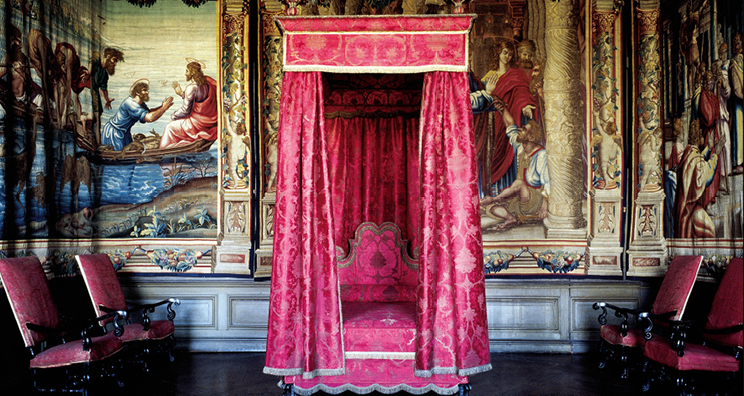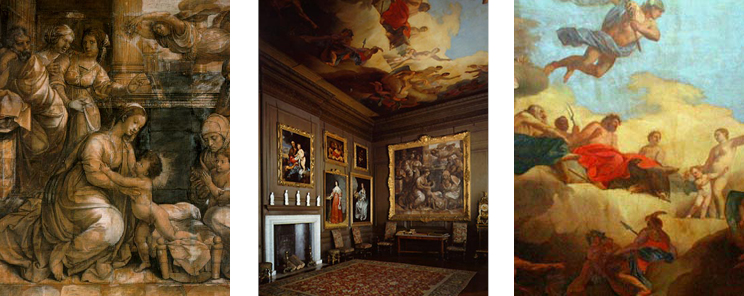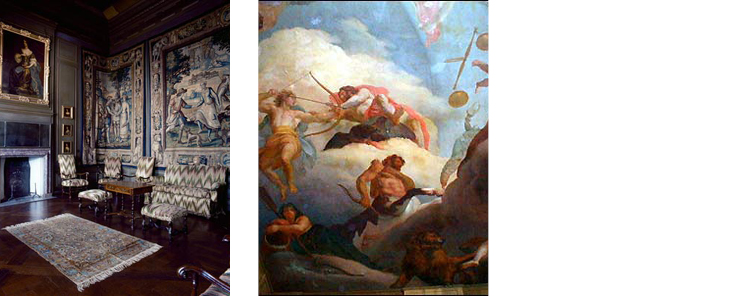The State Rooms
The State Rooms at Boughton House were originally built to impress the King and Queen, William and Mary, by showing them the contemporary style and tastes of the French Court.
Visitors to Boughton House can enjoy the processional tour of the State Rooms or ‘Great Apartment’ that had such an impression on King William III that he commissioned the building of State Rooms in his Hampton Court Palace.
As Master of The Wardrobe, Ralph, Earl of Montagu, later 1st Duke of Montagu, was responsible for furnishing the Royal Palaces and cultivated many northern European artists and craftsmen, including many Huguenots such as the architect, engraver and furniture designer Daniel Marot and gilders like the Pelletiers. Works by these designers and craftsmen can be found throughout the State Rooms.
Most notable are the stunning ceilings in each of the State Rooms executed by the Huguenot artist Louis Chéron. These are now part of an extensive restoration project, which seeks to bring them back to their full glory and ensure that they are enjoyed for another three hundred years.
Several of the rooms have tapestries from the “The Acts of the Apostles” set, created at the Mortlake works in the reign of Charles II from the cartoons by Raphael.
The First State Room (The King’s Dining Room)
From the head of the Grand Staircase, the visitor enters the first of the State Rooms, where the walls are dominated by two huge tapestry cartoons attributed to Tommaso Vincidor, a pupil of Raphal and created in c.1521.
On the East wall is “The Vision of Ezekiel” and on the West wall is The Holy Family with St. Elizabeth and the infant John the Baptist.
Above the central fireplace is a Madonna and Child by Van Dyck, this is flanked by a Madonna and Child by Puligo, c.1520 and a painting by Alessandro Tiarini of “Angelica and Medoro with Cupid”. Other paintings include a number of family portraits and flower paintings by Jean Baptiste Monnoyer.
On the floor, In front of the fireplace is the Buccleuch Sanguszko one of the most magnificent Safavid rugs to be found in Britain.
The ceiling depicts the scene from Greek mythology ‘Venus interceding for Aeneas’.
From left: (1)The Meeting of the Two Holy Families, attributed to Tommaso Vincidor made in c.1521; (2) The First State Room (The King’s Dining Room); (3) Venus interceding for Aeneas – Louis Chéron c. 1695
Second State Room (The State Drawing Room)
In the Second and Third State Rooms there are pieces of tapestry from the “The Acts of the Apostles” set, which were made at the Mortlake works in the reign of Charles II from the cartoons by Raphael. The room displays ‘The Death of Ananias’ and ‘The Sacrifice of Lystra’ Tapestries whilst the ceiling depicts the ‘Fall of Pyranaeus’. Contemporary William and Mary chairs stand with gilt gesso furniture including coffer by James Moore and centre table by Jean Pelletier. Pieces from the same designs, also made at Mortlake, but in the reign of Charles I are hanging in the Fifth State Room and the High Pavillion Bedroom.
The ceiling depicts the ‘Fall of Pyranaeus’:
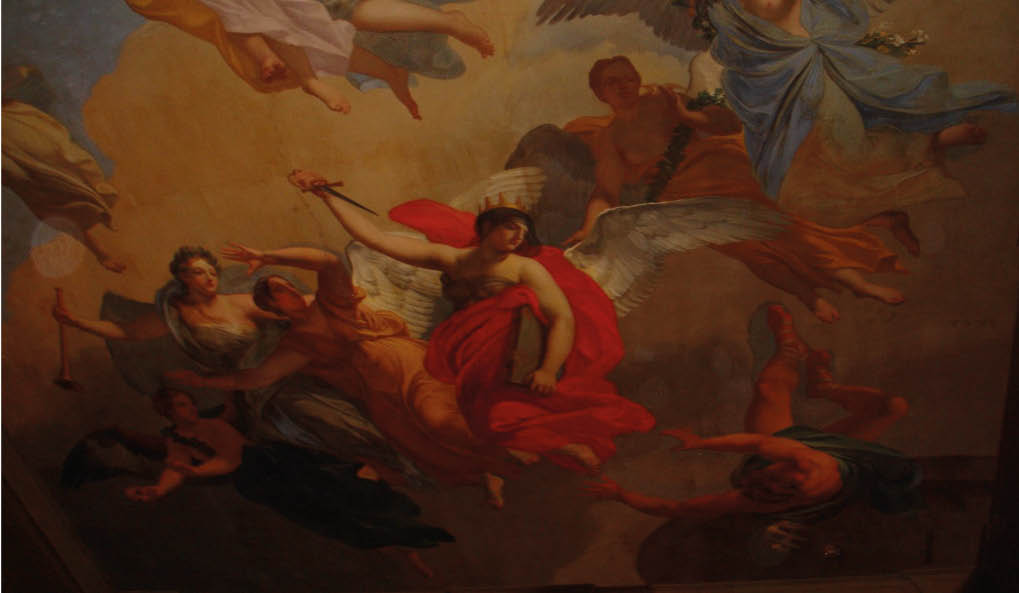 Above: The Fall of Pyranaeus – Louis Chéron, c. 1695
Above: The Fall of Pyranaeus – Louis Chéron, c. 1695
Third State Room
The most important room on the processional route is the Third State Room.
The dominant feature of this room is the Boughton State Bed, with its crimson damask hangings with gold brocading, on a frame of oak and pine, with carved walnut feet painted black and finials of ostrich and egret feathers. Adorning the wall are the tapestries ‘The Miraculous Draught of Fishes’, ‘St Paul Preaching’ and the ‘Healing of the Lame Man’.
The ceiling painting by Cheron is of ‘Vulcan Catching Mars and Venus in his Net’ showing the classical gods Venus and Mars caught in an adulterous liaison by Venus’s husband Vulcan.
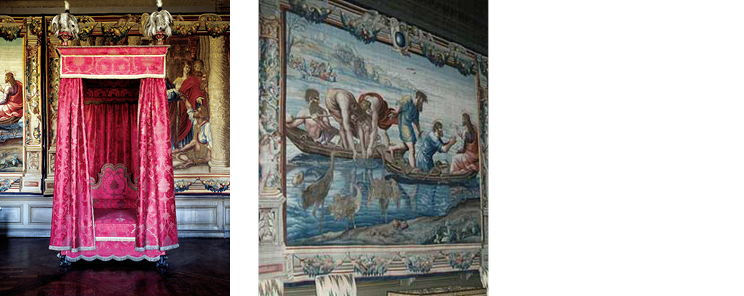
From left: The Boughton State Bed; The Miraculous Draught of Fishes tapestry
Fourth State Room
The Fourth State Room , the formal Withdrawing Room, was a more private retreat for the King. The room contains a number of object d’art including the French Tapestries from the Gombaut and Macée series dating from c. 1650-60.
The ceiling Chéron painting depicts ‘Jupiter restraining Arcas from shooting at the Bear Calisto, his mother, they would become the constellations Ursa Major and Uras Minor’.
The set of eight William and Mary period armchairs are covered with contemporary cross stitch needlework covers in a striking colourful, geometric “Hungarian pattern”, which is also used on the sofa and footstools. There is a Louis XIV Boulle tortoiseshell and brass-inlaid longcase clock attributed to André-Charles Boulle.
From left: The forth State Room; Jupiter restraining Arcas from shooting at the bear Callisto – Louis Chéron, c. 1695
The Fifth State Room
The processional ends in the Fifth State Room.
The ceiling here portrays ‘Cephalus and Aurora’ , a story from Ovid’s ‘Metamorphoses’ where Aurora the goddess of dawn falls in love with a mortal Cephalus the huntsman.
Another large tapestry from the Gombaut and Macée series adorns the wall. The Death of Sapphira” tapestry from the Mortlake works in the reign of Charles I is a vivid reminder of the artisan’s skill and a testament to the stewardship of the Montagu and Buccleuch families, when it is realised to be nearly four hundred years old.
There is also a portrait of Sir Edward Montagu who purchased Boughton in 1528, and today it remains with his direct descendants.
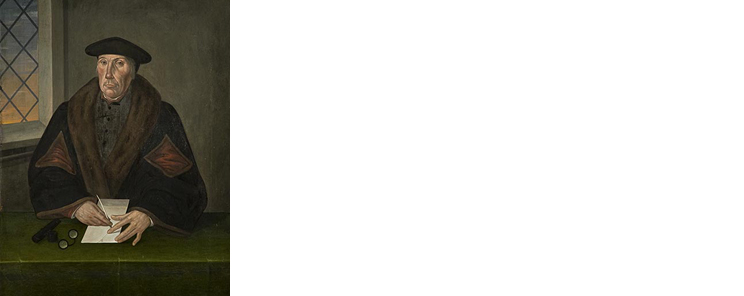
Above: Sir Edward Montagu




